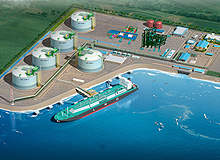
The Singapore liquefied natural gas import terminal is the country’s first LNG regasification facility. Located in Jurong Island, the facility is used for importing LNG, reloading and regasification and storage. It is a hub for physical LNG trading and regional redistribution. The S$1.7bn project was developed by Singapore LNG.
The project is the first open-access multi-user terminal in Asia. It is capable of importing LNG and re-exporting it to various suppliers. The terminal has a capacity of six million tons per annum (mtpa).
The project was constructed on a 30ha site in the south-western part of Jurong Island. Construction on the project began in March 2010 and was completed in May 2013. As of August 2011, the project was 50% complete.
The unused storage capacity in the terminal during the initial years is used for physical LNG trading. As part of storage and reloading service, the traders are able to store and reload LNG for exports. The storage capacity reduces with the increase in domestic LNG demand. With a favourable response from traders for LNG storage, additional storage tanks will be built.
The contract to build and operate the terminal was assigned to PowerGas in September 2007. In June 2009, Singapore’s energy statutory board Energy Market Authority (EMA) took over the responsibility of the development and ownership of the LNG terminal from PowerGas as it was found that the development of the project on commercial lines was not viable.
A new company, named Singapore LNG (SLNG), was formed by the EMA to oversee the development activities of the terminal.
Singapore LNG terminal background
Singapore depends on natural gas for almost 80% of its electricity needs. The country imports natural gas from Indonesia and Malaysia. With forecasts predicting that the demand for gas will exceed that of supply, the country is looking at LNG as an alternative.
In 2005, the EMA appointed Tokyo Gas Engineering to conduct a feasibility study on various ways to import LNG and possible models of an LNG terminal.
LNG terminal construction
The terminal was originally planned with two 188,000m³ storage tanks with a send-out capacity of 3.5mtpa.
In November 2010, SLNG announced the addition of a third 188,000m³ storage tank to the terminal. The third tank provides Singapore with better flexibility to meet future gas requirements.
In addition, a primary jetty with a cargo capacity of 120,000m³-265,000m³ was also constructed. It is capable of accepting the newest and largest Q-max vessels and an LNG carrier.
In August 2011, SLNG launched the Secondary Berth Project for the terminal. The project included construction of a secondary jetty with a cargo capacity of 60,000m³-265,000m³ and a tertiary jetty with cargo capacity of 10,000m3-40,000m³.
The two jetties were constructed on 10ha of land adjacent to the terminal. The secondary jetty includes space for expansion to construct loading arms and associated piping for unloading of LNG. The Secondary Berth Project was completed by the end of 2013.
PowerGas and its partner GDF Suez did the front-end engineering design for the terminal. The development work was taken up by the government.
LNG terminal EPC contract
The engineering, procurement and construction (EPC) contract for the LNG project was awarded to Samsung C&T in February 2010. The contract was valued at KRW731bn (S$798m). Samsung C&T was also awarded the contract for the third storage tank and the Secondary Berth Project in January 2011 and August 2011, respectively.
Samsung awarded Flour an engineering and related management services contract.
The contract to provide project management consultancy services in support of the development of the terminal was given to Foster Wheeler Asia Pacific.
WorleyParson supplied the basis for design and front-end engineering design. The scope of work also included the development of the EPC contractor tender documents, along with their subsequent assessment and recommendations for selection.
Singapore LNG supply contract
In 2008, BG Singapore Gas Marketing was selected as LNG aggregator for Singapore. As aggregator, BG aggregates demand for regasified LNG from all end-users in Singapore and aimed at 3mtpa LNG supply starting from 2013.
With the start of construction, six companies entered a long-term gas purchase agreement with BG Singapore Gas Marketing.
The companies are Senoko Energy, PowerSeraya, Tuas Power Generation, SembCorp Cogen, Keppel Merlimau Cogen and Island Power Company.
The companies have agreed to purchase 2mtpa of re-gasified LNG.


